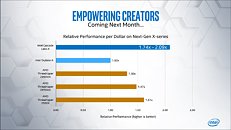Tuesday, October 1st 2019

Intel 10th Gen Core X "Cascade Lake" HEDT Processors Launch on October 7
October 7 promises to be an action-packed day, with not just AMD's launch of its Radeon RX 5500 series graphics card, but also Intel's 10th generation Core X "Cascade Lake" HEDT processors in the LGA2066 package. With AMD having achieved near-parity with Intel on IPC, the focus with the 10th generation Core X will be on price-performance, delivering double the number of cores to the Dollar compared to the previous generation. Intel will nearly halve the "Dollars per core" metric of these processors down to roughly $57 per core compared to $103 per core of the 9th generation Core X. This means the 10-core/20-thread model that the series starts with, will be priced under $600.
The first wave of these processors will include the 10-core/20-thread Core i9-10900XE, followed by the 12-core/24-thread i9-10920XE around the $700-mark, the 14-core/28-thread i9-10940XE around the $800-mark, and the range-topping 18-core/28-thread i9-10960XE at $999, nearly half that of the previous-generation i9-9980XE. There is a curious lack of a 16-core model. These chips feature a 44-lane PCI-Express gen 3.0 root complex, a quad-channel DDR4 memory interface supporting up to 256 GB of DDR4-2933 memory (native speed), and compatibility with existing socket LGA2066 motherboards with a BIOS update. The chips also feature an updated AES-512 ISA, the new DLBoost instruction set with a fixed-function hardware that accelerates neural net training by 5 times, and an updated Turbo Boost Max algorithm. Intel will extensively market these chips to creators and PC enthusiasts. October 7 will see a paper-launch, followed by November market-availability.
Source:
VideoCardz
The first wave of these processors will include the 10-core/20-thread Core i9-10900XE, followed by the 12-core/24-thread i9-10920XE around the $700-mark, the 14-core/28-thread i9-10940XE around the $800-mark, and the range-topping 18-core/28-thread i9-10960XE at $999, nearly half that of the previous-generation i9-9980XE. There is a curious lack of a 16-core model. These chips feature a 44-lane PCI-Express gen 3.0 root complex, a quad-channel DDR4 memory interface supporting up to 256 GB of DDR4-2933 memory (native speed), and compatibility with existing socket LGA2066 motherboards with a BIOS update. The chips also feature an updated AES-512 ISA, the new DLBoost instruction set with a fixed-function hardware that accelerates neural net training by 5 times, and an updated Turbo Boost Max algorithm. Intel will extensively market these chips to creators and PC enthusiasts. October 7 will see a paper-launch, followed by November market-availability.

35 Comments on Intel 10th Gen Core X "Cascade Lake" HEDT Processors Launch on October 7
Point is, Nvidia has absolute dominance in the ML/DL/AI hardware market. They have a very mature software ecosystem as well and a super good customer service team dedicated to researchers across the globe. It will take some serious effort from Intel to bite off a piece from this ever increasing pie.
Also the pricing really lets you know how much they were making with their almost monopoly built on sketchy security riddled products.
Let me be frank with the example you provided, if one buys a whole bunch of those eye-wateringly expensive AMD Instinct cards but they end up using DL boost on CPUs to accelerate their ML workloads that means they are severely out of touch with whatever they were supposed to accomplish.
I can't find a single instance when these CPU would make sense over any other GPU solution as far as ML is concerned, there just isn't any. It's a feature stuck in a no man's land. Intel has upcoming GPUs so why do they insist on these solutions that are clearly not up to the task is beyond me.
Cascade Lake-SP/X have always had a mesh interconnect.